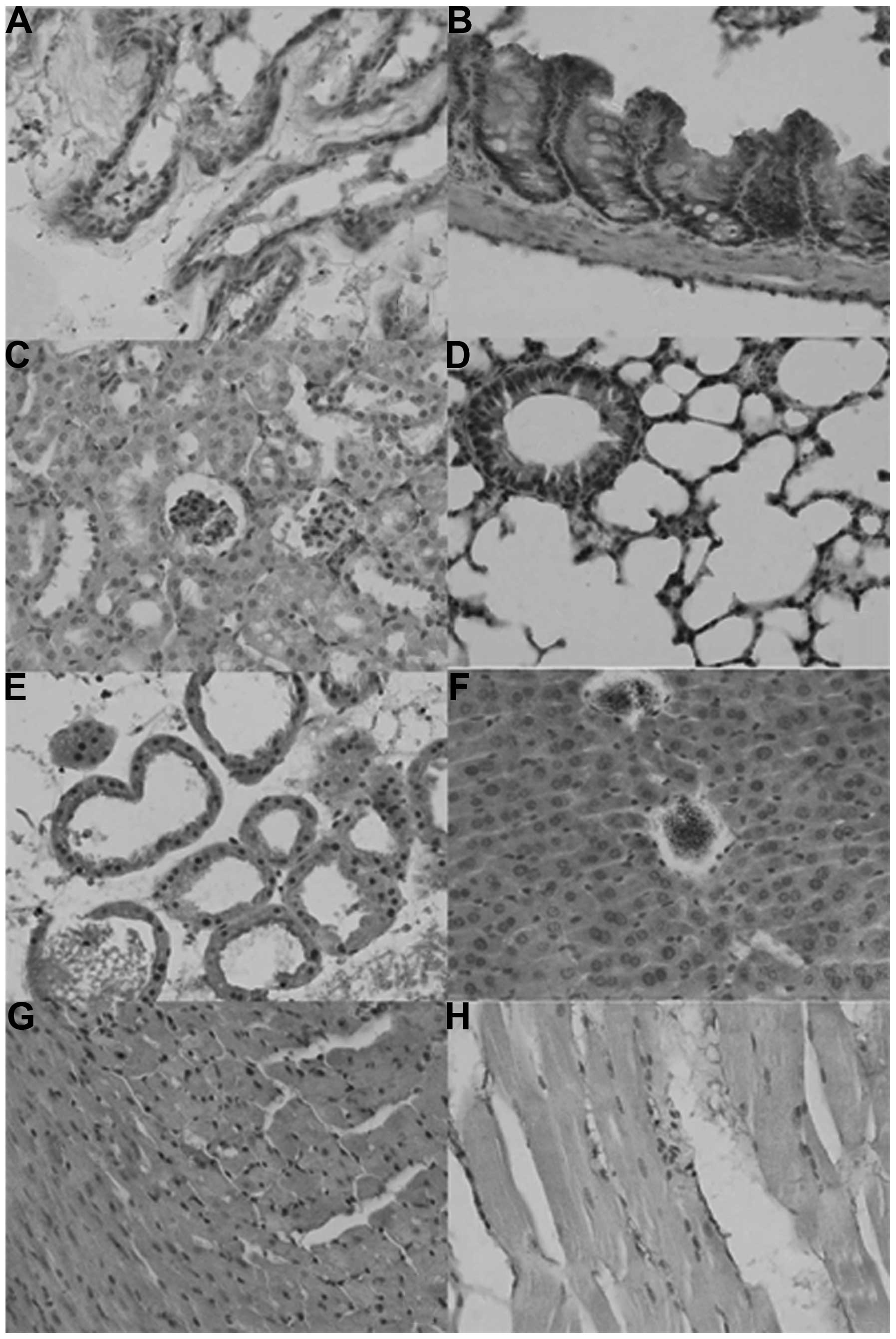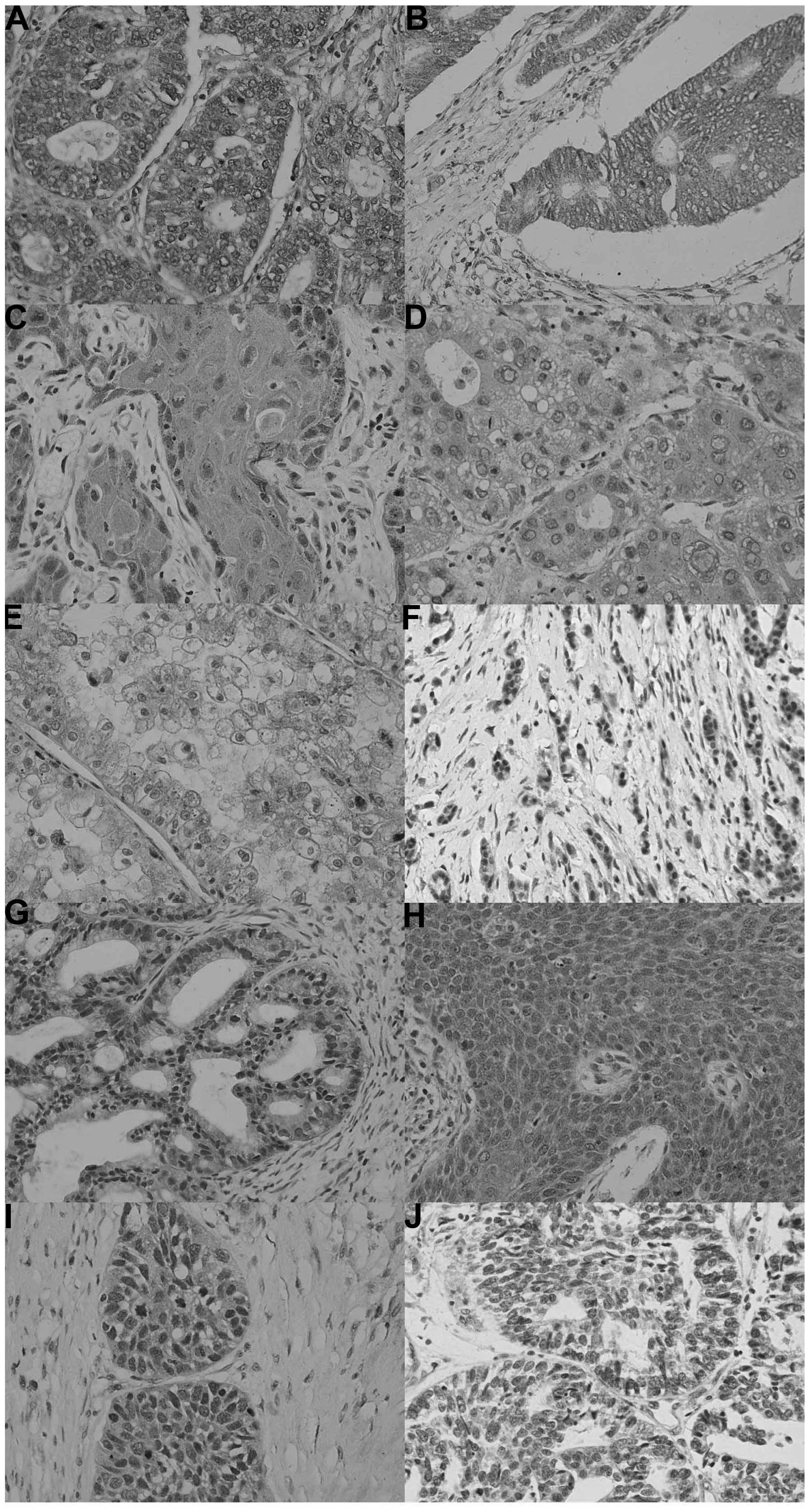|
1
|
Guérillon C, Larrieu D and Pedeux R: ING1
and ING2: Multifaceted tumor suppressor genes. Cell Mol Life Sci.
70:3753–3772. 2013. View Article : Google Scholar : PubMed/NCBI
|
|
2
|
Pedeux R, Sengupta S, Shen JC, Demidov ON,
Saito S, Onogi H, Kumamoto K, Wincovitch S, Garfeld SH, McMenamin
M, et al: ING2 regulates the onset of replicative senescence by
induction of p300-dependent p53 acetylation. Mol Cell Biol.
25:6639–6648. 2005. View Article : Google Scholar : PubMed/NCBI
|
|
3
|
Bua DJ, Martin GM, Binda O and Gozani O:
Nuclear phosphatidylinositol-5-phosphate regulates ING2 stability
at discrete chromatin targets in response to DNA damage. Sci Rep.
3:21372013. View Article : Google Scholar : PubMed/NCBI
|
|
4
|
Larrieu D, Ythier D, Brambilla C and
Pedeux R: ING2 controls the G1 to S-phase transition by regulating
p21 expression. Cell Cycle. 9:3984–3990. 2010. View Article : Google Scholar : PubMed/NCBI
|
|
5
|
Gozani O, Karuman P, Jones DR, Ivanov D,
Cha J, Lugovskoy AA, Baird CL, Zhu H, Field SJ, Lessnick SL, et al:
The PHD finger of the chromatin-associated protein ING2 functions
as a nuclear phosphoinositide receptor. Cell. 114:99–111. 2003.
View Article : Google Scholar : PubMed/NCBI
|
|
6
|
Huang W, Zhang H, Davrazou F, Kutateladze
TG, Shi X, Gozani O and Prestwich GD: Stabilized
phosphatidylinositol-5-phosphate analogues as ligands for the
nuclear protein ING2: Chemistry, biology and molecular modeling. J
Am Chem Soc. 129:6498–6506. 2007. View Article : Google Scholar : PubMed/NCBI
|
|
7
|
Jones DR, Bultsma Y, Keune WJ, Halstead
JR, Elouarrat D, Mohammed S, Heck AJ, D'Santos CS and Divecha N:
Nuclear PtdIns5P as a transducer of stress signaling: An in vivo
role for PIP4Kbeta. Mol Cell. 23:685–695. 2006. View Article : Google Scholar : PubMed/NCBI
|
|
8
|
Ythier D, Larrieu D, Binet R, Binda O,
Brambilla C, Gazzeri S and Pedeux R: Sumoylation of ING2 regulates
the transcription mediated by Sin3A. Oncogene. 29:5946–5956. 2010.
View Article : Google Scholar : PubMed/NCBI
|
|
9
|
Nie J, Liu L, Wu M, Xing G, He S, Yin Y,
Tian C, He F and Zhang L: HECT ubiquitin ligase smurf1 targets the
tumor suppressor ING2 for ubiquitination and degradation. FEBS
Lett. 584:3005–3012. 2010. View Article : Google Scholar : PubMed/NCBI
|
|
10
|
Sarker KP, Kataoka H, Chan A, Netherton
SJ, Pot I, Huynh MA, Feng X, Bonni A, Riabowol K and Bonni S: ING2
as a novel mediator of transforming growth factor-beta-dependent
responses in epithelial cells. J Biol Chem. 283:13269–13279. 2008.
View Article : Google Scholar : PubMed/NCBI
|
|
11
|
Walzak AA, Veldhoen N, Feng X, Riabowol K
and Helbing CC: Expression profiles of mRNA transcript variants
encoding the human inhibitor of growth tumor suppressor gene family
in normal and neoplastic tissues. Exp Cell Res. 314:273–285. 2008.
View Article : Google Scholar
|
|
12
|
Saito M, Kumamoto K, Robles AI, Horikawa
I, Furusato B, Okamura S, Goto A, Yamashita T, Nagashima M, Lee TL,
et al: Targeted disruption of Ing2 results in defective
spermatogenesis and development of soft-tissue sarcomas. PLoS One.
5:e155412010. View Article : Google Scholar : PubMed/NCBI
|
|
13
|
Nagashima M, Shiseki M, Miura K, Hagiwara
K, Linke SP, Pedeux R, Wang XW, Yokota J, Riabowol K and Harris CC:
DNA damage-inducible gene p33ING2 negatively regulates cell
proliferation through acetylation of p53. Proc Natl Acad Sci USA.
98:9671–9676. 2001. View Article : Google Scholar : PubMed/NCBI
|
|
14
|
Sironi E, Cerri A, Tomasini D, Sirchia SM,
Porta G, Rossella F, Grati FR and Simoni G: Loss of heterozygosity
on chromosome 4q32–35 in sporadic basal cell carcinomas: Evidence
for the involvement of p33ING2/ING1L and SAP30 genes. J Cutan
Pathol. 31:318–322. 2004. View Article : Google Scholar : PubMed/NCBI
|
|
15
|
Borkosky SS, Gunduz M, Nagatsuka H, Beder
LB, Gunduz E, Ali MA, Rodriguez AP, Cilek MZ, Tominaga S, Yamanaka
N, et al: Frequent deletion of ING2 locus at 4q35.1 associates with
advanced tumor stage in head and neck squamous cell carcinoma. J
Cancer Res Clin Oncol. 135:703–713. 2009. View Article : Google Scholar
|
|
16
|
Cetin E, Cengiz B, Gunduz E, Gunduz M,
Nagatsuka H, Bekir-Beder L, Fukushima K, Pehlivan D, N MO,
Nishizaki K, et al: Deletion mapping of chromosome 4q22–35 and
identification of four frequently deleted regions in head and neck
cancers. Neoplasma. 55:299–304. 2008.
|
|
17
|
Zhang HK, Pan K, Wang H, Weng DS, Song HF,
Zhou J, Huang W, Li JJ, Chen MS and Xia JC: Decreased expression of
ING2 gene and its clinicopathological significance in
hepato-cellular carcinoma. Cancer Lett. 261:183–192. 2008.
View Article : Google Scholar
|
|
18
|
Ythier D, Brambilla E, Binet R, Nissou D,
Vesin A, de Fraipont F, Moro-Sibilot D, Lantuejoul S, Brambilla C,
Gazzeri S and Pedeux R: Expression of candidate tumor suppressor
gene ING2 is lost in non-small cell lung carcinoma. Lung Cancer.
69:180–186. 2010. View Article : Google Scholar
|
|
19
|
Lu F, Dai DL, Martinka M, Ho V and Li G:
Nuclear ING2 expression is reduced in human cutaneous melanomas. Br
J Cancer. 95:80–86. 2006. View Article : Google Scholar : PubMed/NCBI
|
|
20
|
Kumamoto K, Fujita K, Kurotani R, Saito M,
Unoki M, Hagiwara N, Shiga H, Bowman ED, Yanaihara N, Okamura S, et
al: ING2 is upregulated in colon cancer and increases invasion by
enhanced MMP13 expression. Int J Cancer. 125:1306–1315. 2009.
View Article : Google Scholar : PubMed/NCBI
|
|
21
|
Kumada T, Tsuneyama K, Hatta H, Ishizawa S
and Takano Y: Improved 1-h rapid immunostaining method using
intermittent microwave irradiation: Practicability based on 5 years
application in Toyama medical and pharmaceutical university
hospital. Mod Pathol. 17:1141–1149. 2004. View Article : Google Scholar : PubMed/NCBI
|
|
22
|
Cengiz BI, Gunduz E, Gunduz M, Beder LB,
Tamamura R, Bagci C, Yamanaka N, Shimizu K and Nagatsuka H:
Tumor-specific mutation and downregulation of ING5 detected in oral
squamous cell carcinoma. Int J Cancer. 127:2088–2094. 2010.
View Article : Google Scholar : PubMed/NCBI
|
|
23
|
Gong W, Russell M, Suzuki K and Riabowol
K: Subcellular targeting of p33ING1b by phosphorylation-dependent
14–3–3 binding regulates p21WAF1 expression. Mol Cell Biol.
26:2947–2954. 2006. View Article : Google Scholar : PubMed/NCBI
|
|
24
|
Yu L, Thakur S, Leong-Quong RY, Suzuki K,
Pang A, Bjorge JD, Riabowol K and Fujita DJ: Src regulates the
activity of the ING1 tumor suppressor. PLoS One. 8:e609432013.
View Article : Google Scholar : PubMed/NCBI
|
|
25
|
Eapen SA, Netherton SJ, Sarker KP, Deng L,
Chan A, Riabowol K and Bonni S: Identification of a novel function
for the chromatin remodeling protein ING2 in muscle
differentiation. PLoS One. 7:e406842012. View Article : Google Scholar : PubMed/NCBI
|
|
26
|
Larrieu D, Ythier D, Binet R, Brambilla C,
Brambilla E, Sengupta S and Pedeux R: ING2 controls the progression
of DNA replication forks to maintain genome stability. EMBO Rep.
10:1168–1174. 2009. View Article : Google Scholar : PubMed/NCBI
|
|
27
|
Goeman F, Otto K, Kyrylenko S, Schmidt O
and Baniahmad A: ING2 recruits histone methyltransferase activity
with methylation site specificity distinct from histone H3 lysines
4 and 9. Biochim Biophys Acta. 1783:1673–1680. 2008. View Article : Google Scholar : PubMed/NCBI
|
|
28
|
Wang Y, Wang J and Li G: Leucine
zipper-like domain is required for tumor suppressor ING2-mediated
nucleotide excision repair and apoptosis. FEBS Lett. 580:3787–3793.
2006. View Article : Google Scholar : PubMed/NCBI
|














